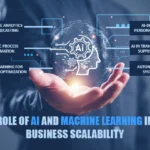The role of the CEO is being redefined by the rise of artificial intelligence (AI). No longer confined to operational oversight or financial forecasting, modern CEOs must now navigate a world where data-driven intelligence, automation, and digital ecosystems shape competitive advantage. In this new paradigm, leadership requires not only vision and decisiveness but also a deep understanding of AI’s potential to reshape every facet of business — from customer engagement to workforce design.
AI has become the most transformative force of the 21st century, driving what experts call the “intelligent transformation.” CEOs who embrace this revolution early are setting their companies apart as adaptive, agile, and insight-driven organizations.
1. Redefining Leadership in the AI Era
The traditional CEO profile — strategic, analytical, and visionary — remains vital, but it’s no longer sufficient. Today’s business environment demands leaders who can translate AI insights into strategic action.
According to a 2025 survey by PwC Global AI Index, 67% of CEOs report that AI adoption is now a board-level priority, while 42% have restructured executive roles to include data-driven decision-making teams. The most forward-thinking leaders are blending business intuition with algorithmic foresight.
Dr. Elena Park, Chief Strategy Officer at the MIT Sloan Center for Digital Leadership, summarizes this shift succinctly:
“The AI-driven CEO doesn’t delegate technology — they internalize it. Leadership now depends on how well you can orchestrate human creativity and machine intelligence toward a common goal.”
2. The CEO’s New Toolbox: Data, Algorithms, and Insight
In the intelligent age, leadership is augmented by data. AI gives CEOs the ability to interpret market signals, detect risks, and identify growth opportunities faster than ever before.
a) Predictive Decision-Making
AI systems like IBM Watson and Google Vertex AI process vast amounts of structured and unstructured data to forecast outcomes with high precision. CEOs can now simulate the potential impacts of mergers, new product launches, or policy shifts across multiple economic conditions — a previously impossible level of foresight.
b) Real-Time Strategic Agility
Machine learning tools continuously monitor performance indicators, flagging deviations and suggesting real-time adjustments. This transforms business management from a quarterly review process into a continuous feedback loop.
For example, multinational logistics companies use AI dashboards that alert executives when geopolitical changes might disrupt supply chains — enabling immediate reallocation of assets.
c) Human Capital Intelligence
AI also revolutionizes how CEOs understand their workforce. By analyzing employee sentiment, productivity, and skill patterns, AI can identify burnout risk, recruitment gaps, and future leadership candidates.
This data-driven awareness is turning HR into a predictive science — allowing leaders to anticipate human needs with the same precision once reserved for financial analytics.
3. The Human + Machine Leadership Model
One of the defining characteristics of AI-era leadership is symbiosis — humans and machines working in tandem. The AI-driven CEO recognizes that automation enhances human capability rather than replacing it.
Dr. Michael Adeyemi, Head of Emerging Technologies at INSEAD, notes:
“True digital leadership isn’t about coding or robotics. It’s about fostering an environment where human creativity thrives alongside algorithmic intelligence.”
In practical terms, this means CEOs must:
- Foster AI literacy across all departments.
- Encourage cross-functional collaboration between tech experts and business leaders.
- Build ethical governance structures to ensure AI decisions align with corporate values.
This synergy of intuition and intelligence creates what many now call the “augmented enterprise” — a company where every decision, from marketing to R&D, is informed by both human judgment and machine precision.
4. Midpoint Insight: Digital Identity and the CEO’s Learning Curve
As CEOs expand their technological engagement, digital literacy and cybersecurity awareness become personal leadership competencies. Executives often participate in virtual forums, AI learning platforms, and innovation labs that require secure identity management and data hygiene.
In this digital leadership landscape, tools like Free Username Generator serve as surprisingly practical aids — helping leaders, educators, and innovation teams create secure, anonymized accounts for sandbox environments, beta testing, or AI collaboration platforms. Such utilities promote privacy and consistency in corporate experiments without exposing sensitive executive information.
More importantly, they represent a symbolic truth about the AI era: even the smallest digital practices, when done securely and intelligently, reflect an organization’s maturity in navigating the technological future.
5. From Digital Strategy to Intelligent Enterprise
AI-driven CEOs are steering companies from digital transformation toward intelligent transformation. This distinction is critical.
Digital transformation focuses on implementing technologies; intelligent transformation focuses on creating adaptive systems that learn and evolve with the market.
a) Intelligent Operations
In manufacturing and logistics, AI predicts equipment failures, optimizes maintenance, and ensures continuous uptime. Tesla, for instance, uses AI to analyze millions of sensor readings from vehicles and factories daily — allowing leadership to make operational decisions based on real-world data rather than assumptions.
b) Intelligent Customer Experience
Personalized engagement powered by AI recommendation engines has redefined customer relationships. CEOs now oversee ecosystems where AI tailors every product suggestion, ad, and service interaction — driving retention and loyalty.
c) Intelligent Ecosystems
Partnerships are increasingly AI-integrated. Supply chains, vendors, and even competitors share data securely through AI-enabled platforms. The CEO’s role becomes one of ecosystem orchestration, not mere oversight.
6. Building Ethical and Transparent AI Governance
As CEOs adopt AI at scale, they face a growing responsibility: ethical governance.
AI systems that make decisions about customers, employees, or investments must operate transparently and without bias.
In 2024, Harvard Business Review reported that 84% of executives consider AI ethics a top reputational risk factor. The AI-driven CEO must therefore ensure:
- Bias auditing for all AI algorithms.
- Explainable AI (XAI) frameworks for accountability.
- Data sovereignty compliance under global standards (GDPR, CCPA, and others).
Forward-looking leaders such as Satya Nadella (Microsoft) and Arvind Krishna (IBM) have positioned ethics as central to their AI strategy — not as compliance, but as competitive differentiation.
7. Leading Organizational Change in the Age of AI
Introducing AI into a corporation is not just a technological project — it’s a cultural transformation.
Employees must trust AI, understand its benefits, and feel empowered by it rather than threatened.
The CEO sets the tone for this cultural shift. By modeling curiosity, adaptability, and transparency, leaders create psychological safety for teams to experiment and learn with AI.
A global Deloitte Insights study found that organizations led by AI-empowered CEOs were 2.8x more likely to achieve successful transformation outcomes than those that viewed AI purely as a technical initiative.
Leadership Practices That Work
- AI education initiatives: Regular workshops to improve digital fluency among executives and managers.
- AI mentorship programs: Pairing data scientists with non-technical teams to build cross-domain understanding.
- Transparent communication: Explaining not only how AI works, but why it’s being adopted.
8. Measuring Success in the Age of Intelligent Transformation
How do AI-driven CEOs define success? Traditional KPIs like revenue and profit remain vital, but new metrics are emerging:
- Decision Velocity: How quickly and accurately can leadership respond to changing conditions using AI insights?
- Innovation Rate: The percentage of new products or services generated through AI-assisted ideation.
- Employee-AI Adoption Index: How effectively employees integrate AI tools into their workflows.
- Ethical Compliance Score: Evaluating bias reduction and data transparency.
These indicators reflect a broader shift from measuring outputs to measuring organizational intelligence.
9. The Global Impact of AI Leadership
The AI-driven CEO is not just transforming corporations — they are influencing economies.
From Africa’s fintech boom to Asia’s AI-powered manufacturing surge, executive leaders are redefining industries by embracing automation, predictive analytics, and digital inclusion.
Countries investing in AI-driven leadership — like Singapore, the UAE, and South Korea — are already outperforming global innovation benchmarks. Their CEOs view AI as a national asset and a strategic imperative, ensuring that corporate growth aligns with sustainable, human-centric progress.
10. The Future CEO: Visionary, Data-Literate, and Ethically Grounded
Tomorrow’s CEO will not be a technologist alone, but a translator between human ambition and machine capability.
They will lead organizations where every process is augmented by intelligence — and where empathy, ethics, and adaptability define success.
As AI becomes the backbone of strategy, leadership must evolve beyond intuition.
The AI-driven CEO will harness algorithms not to replace judgment, but to refine it — transforming uncertainty into insight, and data into wisdom.
Summary: Key Takeaways
- The AI-driven CEO blends intuition with intelligence, vision with data.
- Intelligent transformation replaces static digitalization with adaptive learning systems.
- Ethical governance is the cornerstone of sustainable AI leadership.
- Tools like Free Username Generator symbolize the importance of secure, smart digital identity in leadership ecosystems.
- The future belongs to CEOs who embrace AI as both a strategic and moral responsibility.
In conclusion, the era of the AI-driven CEO is not coming — it’s here.
Leadership has evolved from managing people to orchestrating intelligence. The winners of this new age will be those who understand that in the symphony of humans and machines, the CEO’s role is not to conduct from above — but to harmonize from within.










